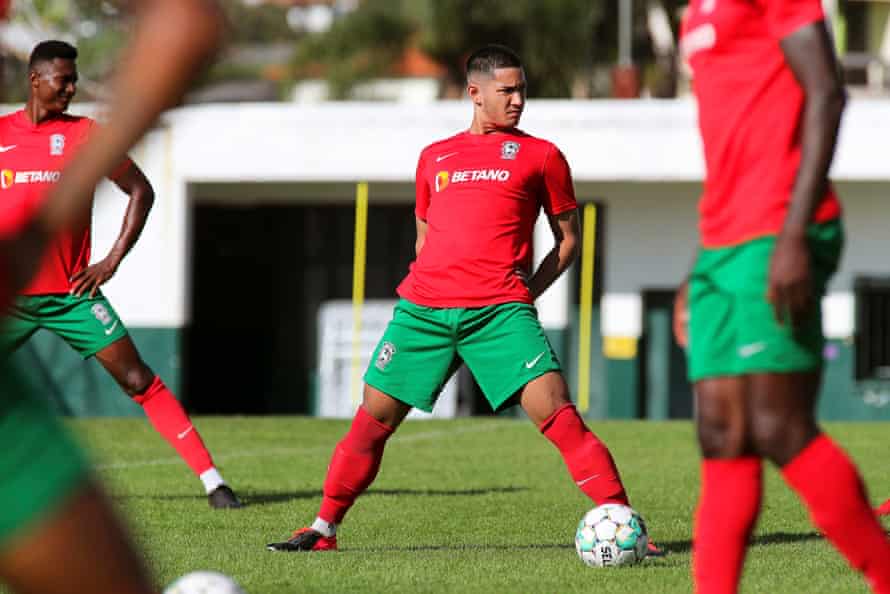“Has any footballer been booked or sent off for scoring a goal in a provocative or over-the-top manner (like stopping the ball on the line and nudging it in with their head)?” wonders Ronan Brennan.
Well, goals bring joy so why not add some decorative detail once in a while. Football is about forging memories, not just filling a history book with scorelines. Can anyone remember Rangers beating Ayr in the 2000 Scottish Cup semi-final? Nope. But we do recall the moment in that game when Andrei Kanchelskis stood on the ball before impudently raising his hand to his head to survey the penalty area. The ultimate showboat probably has to involve a goal, though, so let us begin these examples of embellishment that came with no fear of reprisal.
This happened as recently as last December. “Silas Wamangituka from VfB Stuttgart was booked for unsportsmanlike conduct after holding the ball on the line before scoring against Bremen, triggering much discussion in the German media,” writes Mark Jameson.
“As it transpired, the great Karl-Heinz Rummenigge topped it with this cheek against Club Brugge during a pre-season tournament e in 1981.”
Rummenigge scooped the ball up and headed it over the line to put Bayern 4-0 up in a match they eventually won 5-1. Like Wamangituka, Rummenigge was booked. Unlike Wamangituka, his effort won Goal of the Month. Yep, really.
Not all referees whip out the yellow card in such situations. As far as we can tell, Patrick Kluivert was not punished for taking his time to score during the Netherlands’ 5-5 draw with Belgium, in 1999; nor was Paul-Georges Ntep of Rennes when he went down on all fours to head the ball over the line against Reims in 2014. But Ntep was substituted by his manager, Philippe Montainer, who later said he made the change because Ntep disrespected the opposition team.
Meanwhile, Guffen Helleve has, well, a helluva story from Norway. “In a Norwegian Cup match against Mo in 1987, Bodø/Glimt’s Mini Jakobsen dribbled past two defenders and the keeper, stopped the ball on the goalline and nudged it in with his head,” writes Guffen. “The referee was not amused, and although he didn’t book Jakobsen, he did disallow the goal for unsportsmanlike behaviour.”
More caps than domestic appearances
“Cameroon international goalkeeper Fabrice Ondoa, 25, has played 44 times for his country, yet has only made a total of 38 league appearances,” writes Alex Blackburne. “Is there anyone else who has more international caps than domestic outings?”
Dan Robinson begins the search for anomalies with this. “One name that came straight to mind is Louie Annesley, a young defender at Blackburn. He is yet to make a league appearance for his club, and has only made three career league appearances at a senior professional level to date (while with Lincoln Red Imps in Gibraltar). Despite this, he already has 15 caps for the senior Gibraltar national team.”
And here’s a right royal tale from Anubhav Dasgupta. “The one that jumps to mind here is Faiq Bolkiah. Probably the richest footballer in the world, Bolkiah is the nephew of Brunei’s Sultan. He has never played a senior league game in his career, yet he has six appearances for the Brunei national team, even scoring once against Laos!”
And you thought Messi or Ronaldo topped soccer’s rich list. Bolkiah had a youth career at Arsenal, Chelsea and Leicester and, despite not playing once, was apparently on the books at the King Power from 2016-20 apparently.

Loanee captains
“With Tom Cairney not getting game time, Joachim Andersen is currently captaining Fulham,” writes Jim Miles. “Has there ever been an occasion where a loanee was the full-time captain?”
Paul Moran provides a very recent example. “Sead Kolasinac has been made vice-captain on his loan return to Schalke this month, but due to an injury to the captain, Omar Mascarell, Kola has been the captain for each of his first three Bundesliga games.”
There’s more. “At PSV Eindhoven, Marco van Ginkel (on loan from Chelsea) was the captain in 2017-18,” recalls Stephan Wijnen. “And not only that: at the end of the season he lifted the championship trophy!”

Losing by making too many substitutions
“After Roma’s debacle, has any team ever lost a match by default after making too many substitutions before?” tweets @partsublimated.
Unfortunately, there are others who went to the Graham Poll school of counting.
“It happened in the Bundesliga before, the 1998-99 season,” remembers Ulrich Denzer. “Newly promoted Kaiserslautern were hosting Bochum when Michael Schjonberg had to be taken off due to injury. Coach Otto Rehhagel substituted Pascal Ojigwe, who did not have a European pass at the time, making him ineligible due to the league’s statutes (as each club was only allowed to field a certain number of such players). When Rehhagel noticed the error, he tried to correct it by having Hani Ramzi fake an injury. To no avail. The league commission ended up awarding the game to Bochum.”
Knowledge archive
“Have they ever used an actual hat for the FA Cup draw?” asked Andy Morrison in 2006. “If so, when was it last used, and what kind of hat was it?”
Early draws really did involve headwear; a top hat covered by a handkerchief, to be precise. It was filled with pieces of paper bearing the names of the clubs, with a member of the FA committee delicately lifting a corner of the handkerchief to draw the ties. Bryon Butler’s history of the competition is the only source of information on this arcane ritual, as until the first radio coverage of the draw in December 1935 it was “barred and bolted against all unofficial comers” – including the press. By then, the bag and ball arrangement was in place. Indeed, the then FA secretary, Sir Stanley Rous, was asked by the BBC to rattle the balls in the bag for dramatic effect.
David Barber, the FA’s historian, suggests that the top hat and handkerchief met their demise in a drive for modernisation around 1914. Nevertheless, phrases such as “in the hat for the next round” will always have their roots in the actual routine of the draw.
Can you help?
“Which football clubs have been sponsored by news organisations and have they ever played a game against another team, also sponsored by a news organisation?” ponders Rich Cunningham. “Or has there ever been a sort of old media v new? Newspaper v TV, or similar?”
Question for @TheKnowledge_GU and it might be hard to answer.
What is the longest a tv football commentator (or commentary team) has gone without uttering a single word during a live match broadcast?
— ℂ𝕙𝕣𝕚𝕤 (@salishsea86) February 1, 2021
“All 16 FA Cup fourth-round ties were settled in 90 minutes. Has this ever happened before?” wonders Mitchell Sandler.
Whilst researching the Portugese Primeira Liga during a Football Manager save, I saw the 1946/47 season averaged an astonishing 933 goals in 182 matches (5.13 per match). Even Estoril in 5th scored 96 goals in 26 games! Is this goals-per-match a record, major league or otherwise?
— Rob (@robneedham16) January 30, 2021
“Can you find out why the thrilling 1962 European Cup final was not televised in the UK?” asks Michael Potts. “I seem to remember something about a strike. Is it the only European Cup final not to be seen live in the UK?”
What’s the most penalties saved by a goalkeeper in one season (not incl shootout saves)? Neil Sullivan saved at least four for Leeds in 2004-05 and Willy Gueret at least four for MK Dons in 2007-08 (in all competitions), but not sure if they or indeed anyone else has saved more?
— Steve W (@Whitebait24) February 2, 2021
“Some years ago I remember seeing a clip of a match where a fan ran on the pitch from near the goal and kicked the ball,” writes Eddy Reynolds. “It may have been at Old Trafford in the 1970s at the Stretford End. Anyone know any more?”

Comentarios recientes